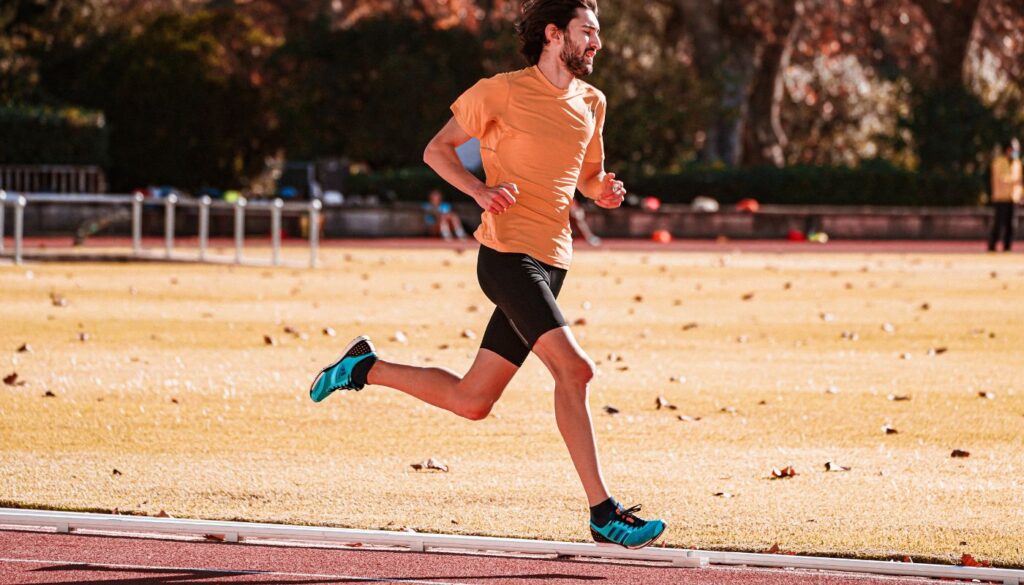Running, a fundamental human activity, has roots stretching back to the dawn of humanity. But when exactly was this form of locomotion ‘invented’, and how has it evolved into the competitive sport and recreational activity we know today? Delve into the history of running, from its survival-based origins to its integral role in ancient ceremonies and modern-day Olympics. Discover the fascinating journey of running through time, and uncover the milestones that transformed it into a global phenomenon.
The Origins of Running as Exercise
The practice of running, a fundamental aspect of human physical activity, has roots that stretch far back into the mists of prehistory. While it is nearly impossible to pinpoint the exact moment when humans first started running for exercise or sport, evidence suggests that the origins of running as an intentional exercise can be traced back to various ancient civilizations. These early instances of running were not solely for the purpose of physical fitness but were intertwined with survival, religious ceremonies, and the establishment of social hierarchies.
In ancient times, running was primarily a method of survival, enabling humans to hunt animals and evade predators. However, as societies evolved, running took on a new role within ceremonial and competitive realms. For example, the Tailteann Games, an ancient Irish festival dating back to 1829 B.C., included races among its various athletic competitions. Similarly, in ancient Greece, running was a key component of the Olympic Games, which began in 776 B.C. The stadion race, a sprint covering the length of the stadium, was the sole event of the first Olympics, highlighting the significance of running in ancient athletic competitions.
Furthermore, running was utilized as a form of military training in many ancient cultures, emphasizing endurance and speed. This practice underscores the transition of running from a survival skill to a disciplined exercise and sport. The endurance and physical prowess demonstrated through running were highly valued in soldiers, making running a critical element of ancient military training regimens.
| Civilization | Earliest Records of Running | Context of Running |
|---|---|---|
| Ancient Ireland | 1829 B.C. | Tailteann Games |
| Ancient Greece | 776 B.C. | Olympic Games |
| Ancient Egypt | c. 3100 B.C. | Ceremonial and Military Training |
| Mesoamerica | c. 1st millennium B.C. | Religious Ceremonies |
| Rome | c. 8th century B.C. | Military Training and Recreation |
This table encapsulates the diversity and ubiquity of running across various ancient civilizations, each incorporating the activity into their culture in unique ways, whether it be through competition, training, or ceremony. The evolution of running from a pragmatic activity to a structured form of exercise and sport is a testament to its universal appeal and importance across human history. Today, running continues to be a popular form of exercise and competition, drawing on its rich heritage to promote physical fitness and endurance. As we lace up our shoes and hit the pavement or the track, we partake in a tradition that has been passed down through millennia, connecting us with our ancient ancestors in a profound and enduring way.
Exploring the Origins of Running

Running, often perceived as a fundamental human activity, does not have a singular point of origin in history. Instead, it evolved alongside humans, with evidence suggesting its presence in the early stages of human evolution. The ability to run long distances is considered to have been crucial for hunting and survival, providing humans with distinct advantages in endurance over other species. This endurance running hypothesis is supported by various anatomical features unique to humans.
Historical records and cave paintings further indicate that running was not only a survival skill but also a form of social and ceremonial activity in ancient civilizations. The first recorded Olympic Games in 776 BCE in ancient Greece included running events, highlighting the sport’s long-standing significance. However, the concept of running for competition, health, and pleasure, as we understand it today, has undergone significant changes throughout the centuries.
The modern era of running began in the late 19th century with the establishment of organized athletic competitions and running clubs. This period marked the transition of running from a necessity and ceremonial activity to a widespread sport and recreational activity. Today, running continues to be a popular form of exercise worldwide, celebrated in events ranging from local 5ks to international marathons.
| Period | Significance | Activity Type |
|---|---|---|
| Early Human Evolution | Survival and hunting | Endurance running |
| 776 BCE | First Olympic Games | Competitive running |
| Ancient Civilizations | Social and ceremonial activities | Various forms |
| Late 19th Century | Organized athletic competitions begin | Sport and recreation |
| Modern Era | Global popularity | Widespread recreational and competitive activity |
Early Civilizations and Running
The inception of running as an organized activity can be traced back to the early civilizations, where it was not only a means for survival but also a cornerstone in various cultural and religious ceremonies. Ancient Egyptians, for example, incorporated running into their military training, valuing speed and endurance. Similarly, in ancient Greece, running was pivotal, epitomized by the establishment of the Olympic Games in 776 BC. These games, held in Olympia, were primarily a religious festival in honor of Zeus, and the stadion race, a sprint of roughly 192 meters, was the sole event initially. This highlights the significance of running not just as a physical activity but as an integral component of worship and community life.
Moreover, running took on various forms across different civilizations. The Tarahumara people of Mexico, known for their long-distance running abilities, utilized these skills for communication and hunting, indicating the versatility and vital role of running in human societies. In contrast, in ancient China, running was intertwined with martial arts, emphasizing agility and stamina. These diverse practices underscore the universality and adaptability of running, making it a fundamental aspect of human culture and civilization.
Running, therefore, has deep roots that extend into the fabric of early human history. Its evolution from a survival skill to a competitive sport and cultural practice illustrates the multifaceted roles it has played across different epochs and societies.
| Civilization | Purpose of Running | Notable Events |
|---|---|---|
| Ancient Egypt | Military Training | N/A |
| Ancient Greece | Religious Ceremony | Olympic Games |
| Tarahumara, Mexico | Communication, Hunting | N/A |
| Ancient China | Martial Arts | N/A |
Running in Ancient Olympic Games
The inception of running as a structured form of competition can be traced back to the ancient Olympic Games, which were initially held in 776 BC in Olympia, Greece. These games were not only a testament to physical prowess but also to honor the gods, particularly Zeus. The ancient Greeks placed a high value on the harmony of body and mind, and running was seen as a crucial discipline to achieve this balance. Among the variety of athletic contests, running events were paramount and showcased the athlete’s speed, stamina, and strategic thinking.
Initially, the only running event at the Olympics was the stadion race, which covered a distance of approximately 192 meters, equivalent to the length of the stadium. Over the years, more running events were introduced, including the diaulos (roughly 384 meters), dolichos (ranging from 7 to 24 stadia), and the hoplitodromos, where competitors ran in armor, adding a significant challenge to the race. These additions not only diversified the competition but also increased the demand for various aspects of physical conditioning and strategy, reflecting the evolution of running from a simple sprint to a complex, multi-dimensional discipline.
The significance of running in the ancient Olympic Games cannot be understated. It was a demonstration of the athletes’ dedication, discipline, and honor, often watched by thousands of spectators, including philosophers, poets, and politicians. The winners of these events were celebrated and immortalized in poems and statues, highlighting the esteem in which these athletes were held. This period marked the beginning of running as a competitive and revered activity, laying the groundwork for the modern sport we know today.
| Event | Distance | Characteristics |
|---|---|---|
| Stadion | Approx. 192 meters | Original and shortest event |
| Diaulos | Approx. 384 meters | Double the length of the stadion |
| Dolichos | 7 to 24 stadia | Long-distance race |
| Hoplitodromos | Varied | Run in full armor |
| Pentathlon | N/A | Included a stadion race as one of five events |
Evolution of Competitive Running
The inception of running as a competitive sport can be traced back to the ancient civilizations, notably among the Greeks, Egyptians, and various African tribes. Initially, running was primarily a form of military exercise, designed to keep soldiers in peak physical condition. However, it quickly transcended its martial origins, evolving into a competitive endeavor that tested the speed, endurance, and spirit of individuals. The first recorded Olympic Games in 776 BC included a stadium race of about 192 meters, marking the formal inception of competitive running. This event underscored the significance of running in ancient cultures, not just as physical exercise but as a crucial societal and ceremonial fixture.
Over the centuries, competitive running underwent significant transformations. In the Middle Ages, foot races were common among the European populace, serving both entertainment and as a means to settle disputes. The Renaissance period saw the emergence of professional running, with athletes competing for prizes and accolades. It was during this era that the concept of racing tracks and standardized distances began to take shape. Modern competitive running, as we recognize it today, started taking form in the 19th century, with the establishment of athletic clubs and the codification of rules. The inclusion of track and field events in the first modern Olympics in 1896 solidified running’s status as a global competitive sport.
Key Milestones in Competitive Running History
| Year | Event | Significance |
|---|---|---|
| 776 BC | First Recorded Olympic Games | Introduction of stadium race |
| 19th Century | Formation of Athletic Clubs | Standardization of rules and distances |
| 1896 | First Modern Olympics | Inclusion of track and field events |
| Early 20th Century | Establishment of IAAF | Global governance of athletic events |
| Mid-20th Century | Introduction of Synthetic Running Tracks | Revolutionized the sport’s infrastructure |
Global Impact and the Future of Competitive Running
Competitive running continues to evolve, with technological advancements and global sporting events propelling it to new heights. Today, it stands not only as a testament to human physical capability but also as a bridge connecting cultures, fostering international camaraderie, and inspiring millions to push the boundaries of what is possible. As we look to the future, the essence of competitive running remains unchanged – a pursuit of excellence, endurance, and the unyielding human spirit.
The 20th Century Running Boom

The 20th century marked a pivotal era in the history of running, transforming it from a basic mode of transportation and a primal survival technique into a global phenomenon of competitive sport and recreational activity. This period witnessed the birth of organized athletics, the rise of international competitions, and the democratization of running as a part of everyday life for people around the world.
The early 1900s saw the establishment of the modern Olympic Games, which played a crucial role in popularizing running as a serious competitive sport. The inclusion of track and field events in the Olympics provided a platform for athletes to showcase their prowess on an international stage, thereby elevating the status of running from a mere pastime to a celebrated sporting activity. This era also saw the emergence of professional athletes who dedicated their lives to perfecting the art and science of running, setting records that inspired generations to come.
However, it was not until the latter half of the century that running truly became ingrained in the cultural fabric of societies worldwide. The 1970s, in particular, witnessed what is often referred to as the “running boom,” a period characterized by an exponential increase in the number of people participating in running as a form of physical exercise and leisure. Several factors contributed to this phenomenon, including increased public awareness about the health benefits of regular exercise, the advent of affordable and specialized running gear, and the influence of charismatic running personalities who captured the public’s imagination.
- The establishment of the modern Olympic Games and inclusion of track and field events
- The emergence of professional runners and record-setting performances
- The 1970s running boom marked by widespread public participation
- Increased awareness of running’s health benefits
- The advent of specialized running gear
Moreover, the 20th century saw the proliferation of running events beyond the Olympic Games, including marathons, half-marathons, and shorter distance races that welcomed participants of all ages and abilities. These events not only provided a platform for elite competition but also encouraged community involvement and fostered a sense of camaraderie among runners. The New York City Marathon, Boston Marathon, and London Marathon, among others, became annual traditions that attracted thousands of runners from across the globe, further cementing running’s place in modern culture.
In conclusion, the 20th century was instrumental in elevating running to its current status as a universally embraced activity. What began as an essential survival skill evolved into a multifaceted sport and a beloved hobby for millions. Through the combined efforts of athletes, organizers, and everyday enthusiasts, running has become more than just a physical activity—it is a symbol of perseverance, health, and community.
Running in the Modern Era
In the tapestry of human history, running has evolved from a primal necessity to a multifaceted component of modern culture. This transformation has been particularly pronounced in the last two centuries, where running has transcended its origins to become a cornerstone of athletic competition, personal health, and social connection. The modern era has witnessed the emergence of running as a professional sport, the proliferation of marathons, and the rise of community running clubs, each reflecting broader societal shifts.
The late 19th and early 20th centuries marked a pivotal point in this evolution, with the establishment of the modern Olympic Games in 1896 serving as a catalyst. This event rekindled the competitive spirit of ancient civilizations, albeit with a newfound emphasis on inclusivity and global camaraderie. Running events quickly became a staple of the Olympics, highlighting the prowess and endurance of athletes from around the world. This period also saw the birth of organized marathons, inspired by the legendary run of Pheidippides from Marathon to Athens. The Boston Marathon, inaugurated in 1897, stands as a testament to the enduring appeal of long-distance running.
The mid-20th century introduced another dimension to running: health and wellness. Medical research began to underscore the cardiovascular benefits of regular running, propelling it from the realm of elite athletes into the domain of everyday people seeking a healthier lifestyle. The latter part of the century witnessed the jogging boom, further democratizing running and embedding it within the social fabric.
| Century | Significant Development | Impact |
|---|---|---|
| 19th | Modern Olympic Games | Revitalized competitive running |
| Early 20th | Establishment of marathons | Popularized long-distance running |
| Mid-20th | Research on health benefits | Running for personal health |
| Late 20th | Jogging boom | Running as a social activity |
Today, running continues to flourish, driven by technological advancements and a growing recognition of its mental health benefits. The advent of wearable technology and running apps has revolutionized training methods, allowing runners to track their progress with unprecedented precision. Meanwhile, the global running community has expanded through social media and online platforms, fostering a sense of unity that transcends geographical boundaries.
The trajectory of running in the modern era underscores its remarkable adaptability and enduring significance. From the dusty tracks of ancient stadiums to the asphalt of contemporary marathons, running remains a universal expression of human potential and perseverance. As we look to the future, it is clear that running will continue to evolve, mirroring the changing contours of society while retaining its core essence as a celebration of movement and life.
This exploration of running’s journey through the modern era reveals not only its transformation but also its timeless appeal. Whether for competition, health, or the sheer joy of movement, running continues to resonate with people across the globe, embodying the spirit of endurance and the pursuit of excellence. As we move forward, the legacy of running, with its rich history and vibrant present, promises to inspire future generations to lace up their shoes and embark on their own running adventures.

Shares expert tips, training plans, and motivational insights to help runners of all levels achieve their goals. When he’s not hitting the pavement or coaching others, he enjoys exploring new trails and participating in local races. Miles believes in the power of community and regularly engages with fellow runners to promote a healthy and active lifestyle. His mission is to inspire others to embrace the joy of running and reach their

